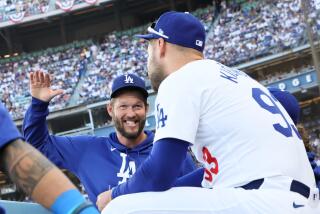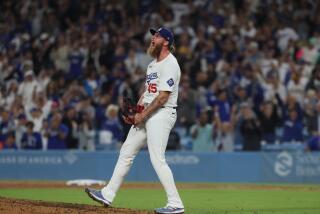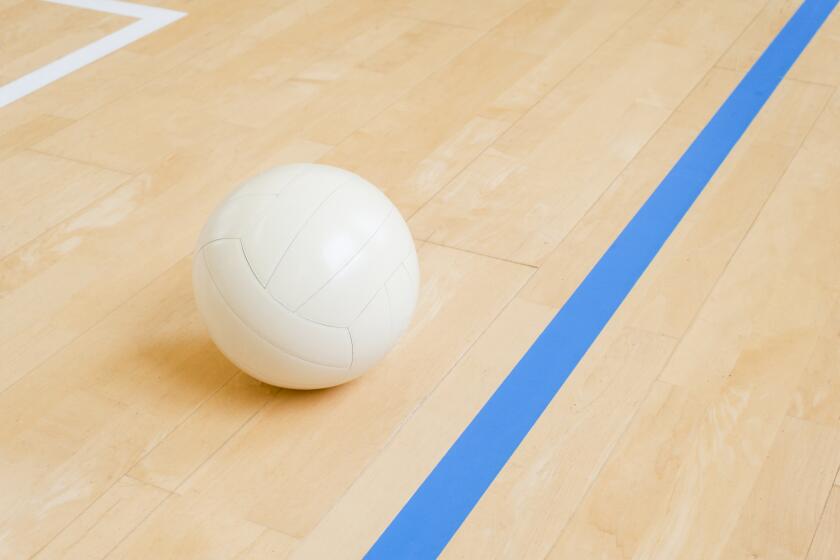Ted Lilly sets lofty goals with Dodgers
Reporting from Phoenix — Ted Lilly speaks the same way he pitches: Deliberately and carefully.
So when the veteran Dodgers left-hander is asked about his goals for this season, he pauses, fixes his gaze on the questioner and replies without emotion: “I want to be celebrating the last game of the World Series.”
Then he adds: “There is some responsibility on my end to help this team get there.”
Some, indeed. Entering his 14th year in the big leagues, Lilly, 36, is a key member of the Dodgers starting rotation who will help determine whether the club returns to postseason play for the first time since 2009 and whether Lilly reaches his first World Series.
The Californian also is a question mark. A durable, crafty pitcher who throws more with finesse and control than power, Lilly has won 10 games or more for nine consecutive seasons.
Yet, he’s often hurt by the home run and, despite being a left-hander, struggles to prevent runners from stealing on him because of his slow, twisty delivery.
“I’m still slow,” Lilly conceded as he dressed for practice at the Dodgers’ Camelback Ranch spring-training complex. But he’s trying to get better at holding runners, who had a 95% success rate stealing against him last year.
“It’s still a little bit of a work in progress finding that right tempo for me, where I can make it difficult for the runner to steal and still execute a pitch, still throw a strike,” he said.
Lilly was 12-14 last year with a 3.97 earned-run average. But he was 5-1 in his last seven starts with a 1.87 ERA.
“I think I can be better,” said Lilly, whose spring locker is next to that of Clayton Kershaw, the National League Cy Young Award winner last year. “I’m still learning things about myself, about the hitters.”
That includes gleaning information from Kershaw. Asked how he likes sitting next to Lilly, Kershaw deadpanned: “If I have to, I have to.”
But Lilly said, “We bounce a lot of ideas off each other. He’s a very smart pitcher.”
A two-time All-Star who is 125-110 with a 4.16 ERA, Theodore Roosevelt Lilly grew up admiring Dodgers Hall of Fame pitcher Sandy Koufax — “the gold standard” for left-handers, Lilly said — and was drafted by the Dodgers in 1996.
The Dodgers traded Lilly while he was in the minor leagues so he began his big league career with the Montreal Expos. Then he moved to the New York Yankees, Oakland Athletics, Toronto Blue Jays and Chicago Cubs, who traded him to the Dodgers in mid-2010. He’s is in the middle of a three-year, $33-million contract.
Lilly, who is scheduled to pitch Wednesday against the San Diego Padres in a Cactus League game, has had a fairly strong spring.
“Teddy’s sharp,” Manager Don Mattingly said after Lilly threw four scoreless innings against the Texas Rangers last weekend. “His stuff is crisper right now than it was last year.”
Catcher A.J. Ellis described Lilly as intense, methodical and well-prepared. Lilly’s main pitches are a four-seam fastball, curveball and changeup.
But “he’s also got a nice backdoor slider he uses for the righties, and he developed a split-finger fastball last year,” Ellis said.
Lilly’s problem holding runners is a weakness, but his delivery overall is a strength that can be tweaked to give base stealers second thoughts, Ellis said.
“You can see the way he turns and cocks his body,” Ellis said. “Ted’s all about creating angles” that make it hard for batters to pick up the ball and “Ted’s not afraid to come inside. He gets more infield popups than any pitcher I’ve ever caught.”
The base-stealing problem is “something we’ve addressed and talked about,” Mattingly said. But in the end, he said, “it isn’t like you’re going to take him out of the rotation because he’s not holding runners.”
The home run also causes Lilly problems when his control gets away from him. He gave up 28 home runs last year, about double those given up by Kershaw (15) and Dodgers starter Chad Billingsley (14).
“It’s no secret that I don’t throw 95 [mph] and I’m certainly not trying to throw 2-0 fastballs down the middle by guys,” Lilly said.
But Lilly said his personal statistics aren’t what matter.
“My objective is finding whatever way necessary to win,” he said, “and trying to get the rest of the guys [on the team] to have the same picture.”
More to Read
Go beyond the scoreboard
Get the latest on L.A.'s teams in the daily Sports Report newsletter.
You may occasionally receive promotional content from the Los Angeles Times.










